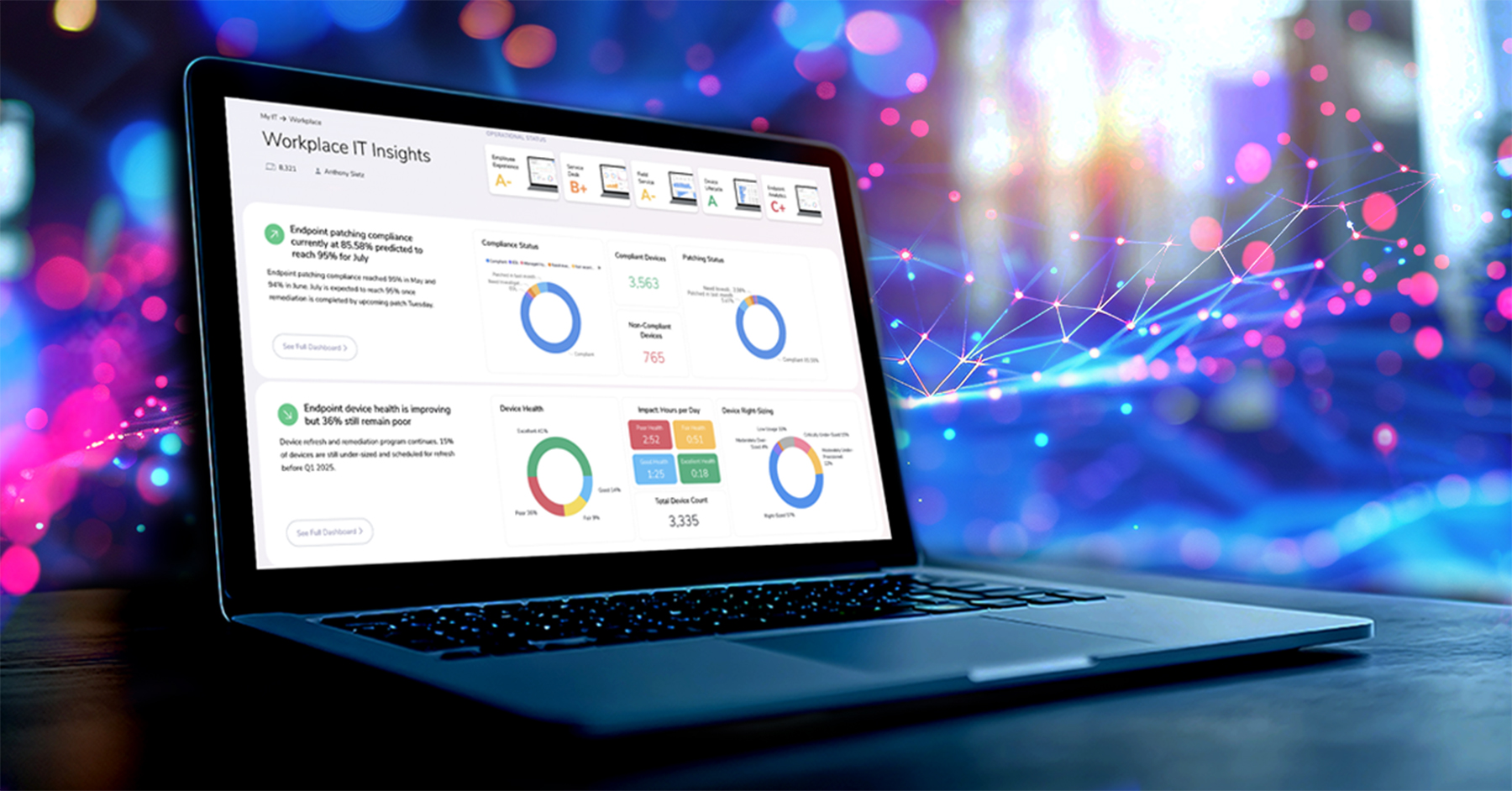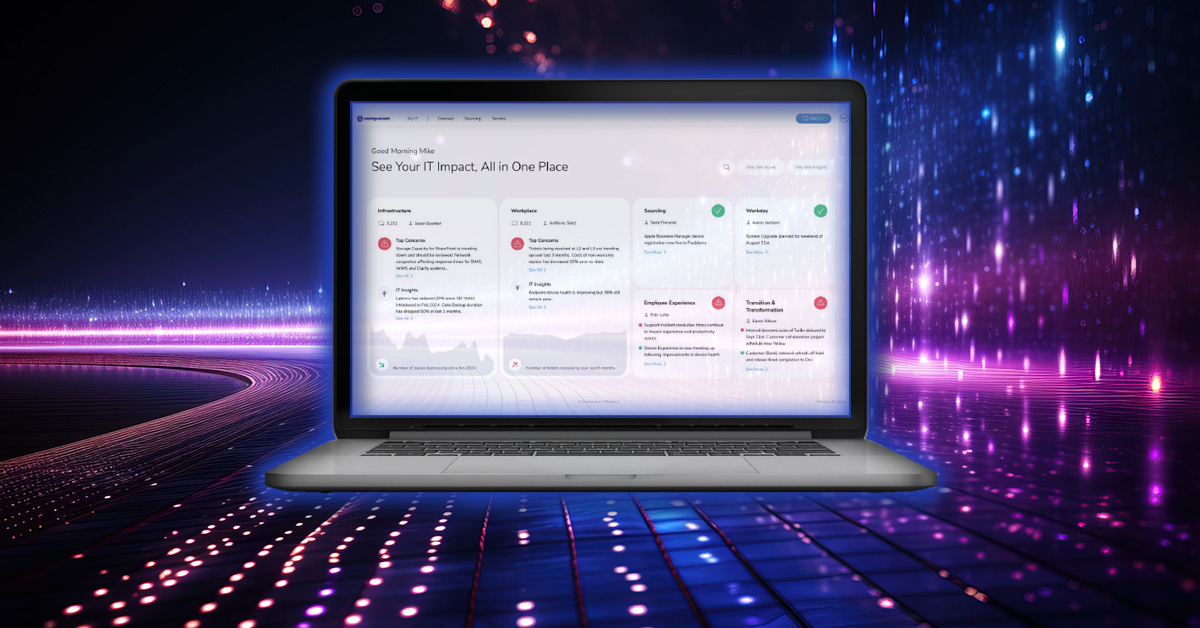- Endpoint Management
- UEM


Emma Mak • Staff Writer
Enterprise workplace technology is a cornerstone for productivity, security, and maintaining a competitive edge. This makes Unified Endpoint Management (UEM) a vital step in digital transformation, offering a streamlined approach to managing the variety of devices employees use daily.
Calming the Chaos
Without a unified method of managing devices, the enterprise faces several significant challenges:
- Fragmented Management: Managing multiple devices (laptops, smartphones, tablets, etc.) across different operating systems without a unified platform can be incredibly complex. IT teams may need various tools and processes, leading to inefficiencies and increased errors.
- Security Vulnerabilities: Ensuring consistent security policies across all endpoints can be difficult. This leaves devices vulnerable to cyberattacks, data breaches, and malware, as there is no centralized way to enforce security measures.
- Compliance Issues: Enterprises must comply with various regulations and standards. Tracking and ensuring compliance across all devices can be daunting, increasing the risk of non-compliance and potential legal consequences.
- Increased IT Workload: IT teams may spend excessive time managing and troubleshooting individual devices. This increases the workload and diverts resources from more strategic initiatives.
- Inconsistent User Experience: Employees might face inconsistent experiences across different devices, leading to frustration and decreased productivity.
- Data Management Challenges: Without a unified approach, managing data across various endpoints can be chaotic. This can lead to data silos, making it difficult to access and analyze information efficiently.
- Higher Costs: The lack of a centralized management system can lead to higher operational costs due to inefficiencies, increased support needs, and potential security incidents.
Implementing UEM helps overcome these challenges, providing a single platform to manage all endpoints, enforce security policies, ensure compliance, and improve overall efficiency.
Understanding UEM
Unified Endpoint Management (UEM) is the evolution of traditional device management. It integrates the management of all endpoints — whether desktops, laptops, or mobile devices — under a single pane of glass. This comprehensive approach enhances oversight and simplifies processes such as device provisioning, configuration, and management.
Compucom employs a suite of leading technologies to deliver these comprehensive UEM solutions effectively, including:
Microsoft Endpoint Manager (MEM) / MECM & Intune
Microsoft Endpoint Manager (MEM) integrates Microsoft Endpoint Configuration Manager (MECM) and Intune to provide a unified management solution for all your devices. This combination allows for centralized management of both on-premises and cloud-based devices. Key features include:
- Co-management: Manage Windows devices using both Configuration Manager and Intune.
- Conditional Access: Ensure only compliant devices can access corporate resources.
- Endpoint Analytics: Gain insights into device performance and user experience.
Jamf
Jamf specializes in managing Apple devices, offering a comprehensive solution for macOS, iOS, iPadOS, and tvOS. It is widely used in enterprises, schools, and hospitals. Key features include:
- Zero-touch deployment: Automatically configure and provision Apple devices without IT intervention.
- BYOD support: Manage both corporate and personal devices while maintaining user privacy.
- Security and Compliance: Ensure devices are secure and compliant with organizational policies.
The Benefits of UEM
1. Enhanced Security and Compliance
Data breaches severely damage an organization’s reputation and finances. UEM bolsters endpoint security by ensuring that all devices adhere to security policies, minimizing vulnerabilities. Compliance is seamlessly managed through Conditional Access policies, which help protect sensitive enterprise data.
2. Increased Efficiency and Reduced Costs
UEM streamlines end-to-end device management, reducing the time and resources required to manage each device. This allows IT teams to focus on strategic initiatives instead of routine maintenance, translating to significant cost savings and productivity gains.
3. Improved User Experience
With UEM, device management is no longer a bottleneck; instead, it becomes a facilitator of productivity. Employees enjoy a seamless experience across devices, with their configurations and applications consistently up-to-date. This enhances satisfaction and reduces downtime, directly improving productivity.
4. Proactive Device Health Management
Compucom’s UEM solutions include Experience Management, which uses endpoint analytics to proactively manage device health. By providing insights into the end-user device experience, IT teams can address potential issues before they impact productivity. This foresight ensures a more efficient work environment.
5. Future-Proofing the Enterprise
The pace of technological change is relentless, and it’s a challenge to keep up and stay agile. UEM provides a scalable solution that grows with the organization, accommodating new devices, applications, and platforms as they emerge. This adaptability is key to maintaining a competitive edge.
UEM as Part of Modern Device Management
Compucom’s UEM services cater to the multifaceted needs of the modern workplace. We offer both cloud and on-prem management solutions, supporting a wide range of devices, including Windows, MacOS, and mobile/BYO devices. Our services include:
- Device Provisioning and Enrollment
- OS Servicing
- Device Configuration Management
- Device Security and Compliance Management
- Application Management
- Endpoint Analytics
UEM is an integral part of our Modern Device Management offering, which also features Virtual Desktop Services, Workplace Telemetry & Automation, and Device as a Service.
We’re committed to unlocking your business potential through digital transformation initiatives such as our UEM services. By integrating technologies like Microsoft Endpoint Manager and Jamf, we provide comprehensive solutions tailored to your unique needs.
For IT leaders, the decision to implement UEM is about empowering their organization to thrive in a digital-first world. Ready to transform your enterprise with UEM? Our team of experts is here to guide you every step of the way. Contact us today to learn more about our Modern Device Management workshops and how Compucom can elevate your IT strategy and drive true digital transformation.
RecenT

9 Ways Strategic IT Staffing Empowers Organizations

Case Studies: Asset Intelligence and Endpoint Compliance Made Easy

AI and the Enterprise: The Future of IT Management

Exploring the Opportunities and Obstacles of AI in the Enterprise

One Dashboard to Rule Them All: Strategic IT Excellence with Full Lifecycle Observability

Transforming IT Operations with Full Lifecycle Observability: How Compucom’s FLO Framework Redefines Data-Driven Efficiency
TOPICS
From Chaos to Control: Get Smart About UEM in the Enterprise
- Endpoint Management
- UEM

Emma Mak • Staff Writer
Enterprise workplace technology is a cornerstone for productivity, security, and maintaining a competitive edge. This makes Unified Endpoint Management (UEM) a vital step in digital transformation, offering a streamlined approach to managing the variety of devices employees use daily.
Calming the Chaos
Without a unified method of managing devices, the enterprise faces several significant challenges:
- Fragmented Management: Managing multiple devices (laptops, smartphones, tablets, etc.) across different operating systems without a unified platform can be incredibly complex. IT teams may need various tools and processes, leading to inefficiencies and increased errors.
- Security Vulnerabilities: Ensuring consistent security policies across all endpoints can be difficult. This leaves devices vulnerable to cyberattacks, data breaches, and malware, as there is no centralized way to enforce security measures.
- Compliance Issues: Enterprises must comply with various regulations and standards. Tracking and ensuring compliance across all devices can be daunting, increasing the risk of non-compliance and potential legal consequences.
- Increased IT Workload: IT teams may spend excessive time managing and troubleshooting individual devices. This increases the workload and diverts resources from more strategic initiatives.
- Inconsistent User Experience: Employees might face inconsistent experiences across different devices, leading to frustration and decreased productivity.
- Data Management Challenges: Without a unified approach, managing data across various endpoints can be chaotic. This can lead to data silos, making it difficult to access and analyze information efficiently.
- Higher Costs: The lack of a centralized management system can lead to higher operational costs due to inefficiencies, increased support needs, and potential security incidents.
Implementing UEM helps overcome these challenges, providing a single platform to manage all endpoints, enforce security policies, ensure compliance, and improve overall efficiency.
Understanding UEM
Unified Endpoint Management (UEM) is the evolution of traditional device management. It integrates the management of all endpoints — whether desktops, laptops, or mobile devices — under a single pane of glass. This comprehensive approach enhances oversight and simplifies processes such as device provisioning, configuration, and management.
Compucom employs a suite of leading technologies to deliver these comprehensive UEM solutions effectively, including:
Microsoft Endpoint Manager (MEM) / MECM & Intune
Microsoft Endpoint Manager (MEM) integrates Microsoft Endpoint Configuration Manager (MECM) and Intune to provide a unified management solution for all your devices. This combination allows for centralized management of both on-premises and cloud-based devices. Key features include:
- Co-management: Manage Windows devices using both Configuration Manager and Intune.
- Conditional Access: Ensure only compliant devices can access corporate resources.
- Endpoint Analytics: Gain insights into device performance and user experience.
Jamf
Jamf specializes in managing Apple devices, offering a comprehensive solution for macOS, iOS, iPadOS, and tvOS. It is widely used in enterprises, schools, and hospitals. Key features include:
- Zero-touch deployment: Automatically configure and provision Apple devices without IT intervention.
- BYOD support: Manage both corporate and personal devices while maintaining user privacy.
- Security and Compliance: Ensure devices are secure and compliant with organizational policies.
The Benefits of UEM
1. Enhanced Security and Compliance
Data breaches severely damage an organization’s reputation and finances. UEM bolsters endpoint security by ensuring that all devices adhere to security policies, minimizing vulnerabilities. Compliance is seamlessly managed through Conditional Access policies, which help protect sensitive enterprise data.
2. Increased Efficiency and Reduced Costs
UEM streamlines end-to-end device management, reducing the time and resources required to manage each device. This allows IT teams to focus on strategic initiatives instead of routine maintenance, translating to significant cost savings and productivity gains.
3. Improved User Experience
With UEM, device management is no longer a bottleneck; instead, it becomes a facilitator of productivity. Employees enjoy a seamless experience across devices, with their configurations and applications consistently up-to-date. This enhances satisfaction and reduces downtime, directly improving productivity.
4. Proactive Device Health Management
Compucom’s UEM solutions include Experience Management, which uses endpoint analytics to proactively manage device health. By providing insights into the end-user device experience, IT teams can address potential issues before they impact productivity. This foresight ensures a more efficient work environment.
5. Future-Proofing the Enterprise
The pace of technological change is relentless, and it’s a challenge to keep up and stay agile. UEM provides a scalable solution that grows with the organization, accommodating new devices, applications, and platforms as they emerge. This adaptability is key to maintaining a competitive edge.
UEM as Part of Modern Device Management
Compucom’s UEM services cater to the multifaceted needs of the modern workplace. We offer both cloud and on-prem management solutions, supporting a wide range of devices, including Windows, MacOS, and mobile/BYO devices. Our services include:
- Device Provisioning and Enrollment
- OS Servicing
- Device Configuration Management
- Device Security and Compliance Management
- Application Management
- Endpoint Analytics
UEM is an integral part of our Modern Device Management offering, which also features Virtual Desktop Services, Workplace Telemetry & Automation, and Device as a Service.
We’re committed to unlocking your business potential through digital transformation initiatives such as our UEM services. By integrating technologies like Microsoft Endpoint Manager and Jamf, we provide comprehensive solutions tailored to your unique needs.
For IT leaders, the decision to implement UEM is about empowering their organization to thrive in a digital-first world. Ready to transform your enterprise with UEM? Our team of experts is here to guide you every step of the way. Contact us today to learn more about our Modern Device Management workshops and how Compucom can elevate your IT strategy and drive true digital transformation.
Recent Blogs

9 Ways Strategic IT Staffing Empowers Organizations

Case Studies: Asset Intelligence and Endpoint Compliance Made Easy

AI and the Enterprise: The Future of IT Management

Exploring the Opportunities and Obstacles of AI in the Enterprise

One Dashboard to Rule Them All: Strategic IT Excellence with Full Lifecycle Observability




